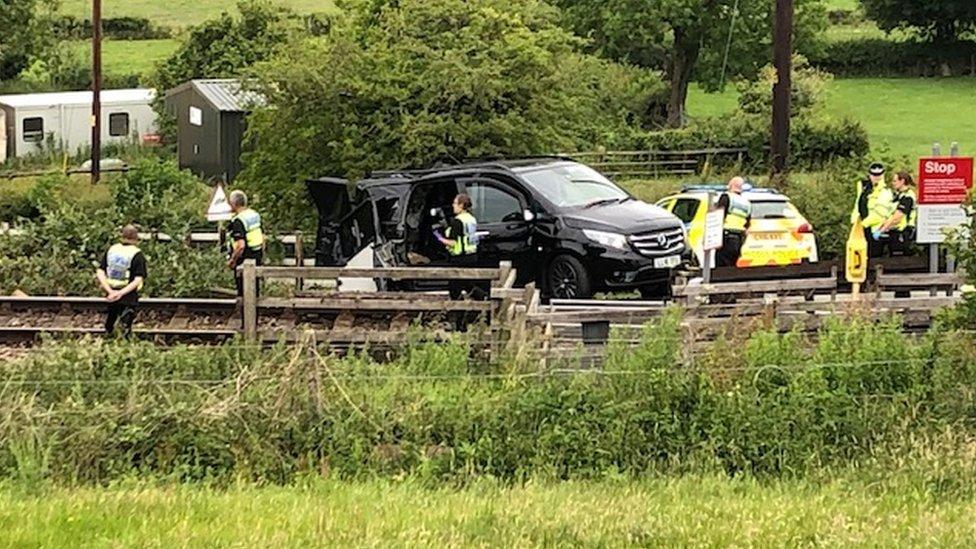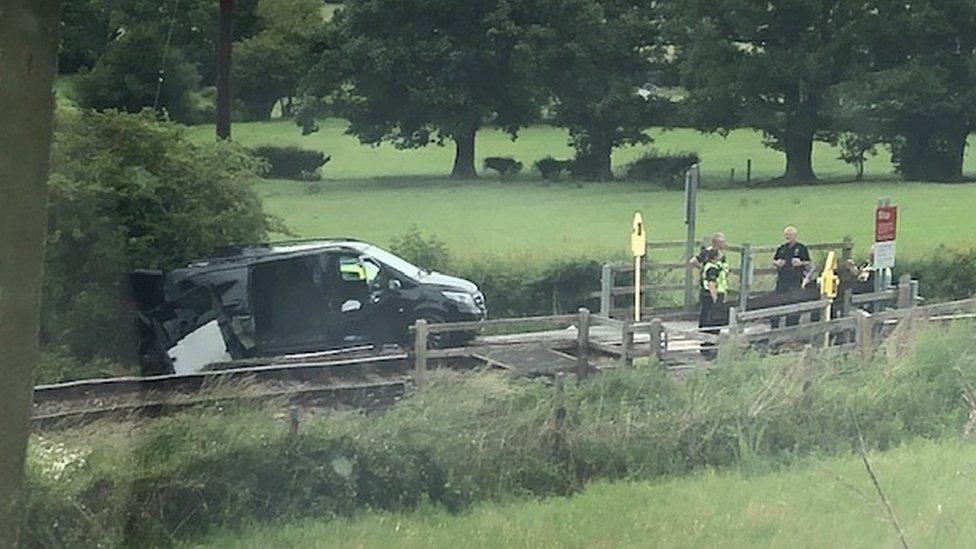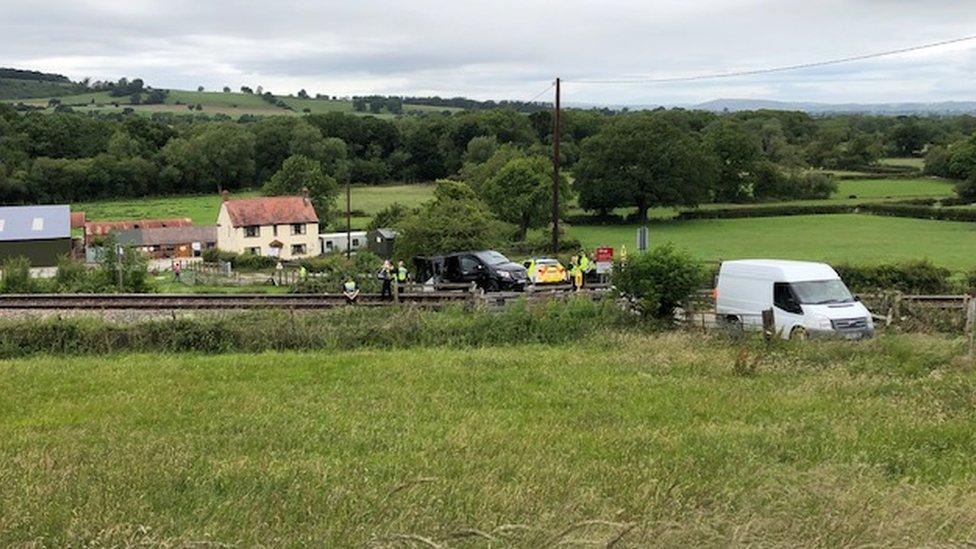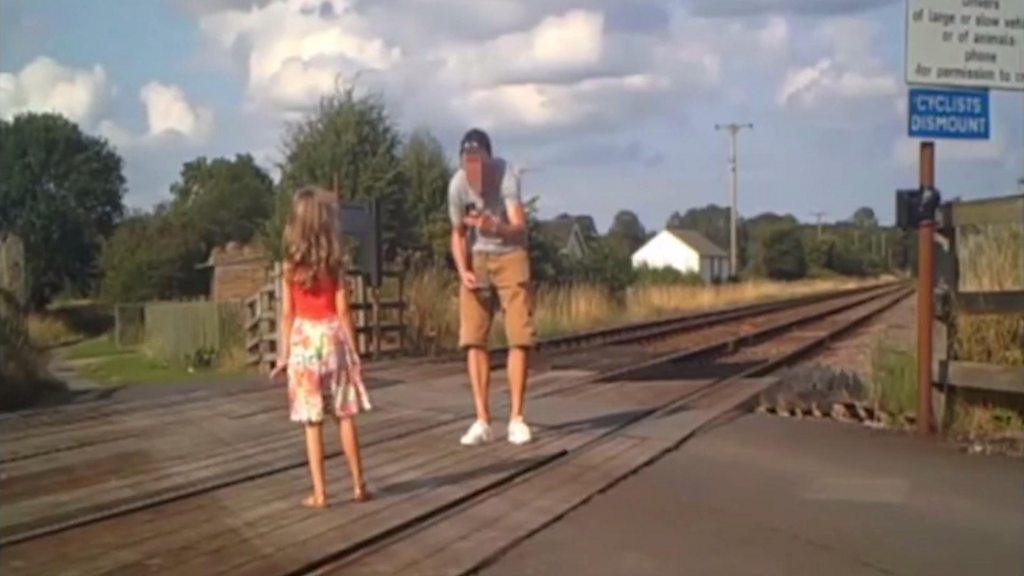Wales' level crossings need urgent safety changes, report says
- Published

A van driver was left with life-changing injuries after their vehicle was hit on a level crossing
A driver was seriously hurt when their van was hit by a train at a level crossing where safety changes were first demanded 12 years before.
They suffered life-changing injuries at the private Smiths Lower Cefn crossing in Powys, last June.
A Rail Accident Investigation Branch (RAIB) report found the driver may not have known they needed to call the signaller before crossing.
The Department for Transport (DfT) said it agreed signs "needs updating".
The RAIB first warned in 2009 in a report into another crash that signs at user-operated level crossings needed to be made clearer.
It has made similar demands in several reports into level crossing crashes in the following years.

The Rail Accident Investigation Branch launched a probe into the crash, which happened last June
User-worked crossings are found where railways cross a right of way, such as a road on private land, a footpath or a bridleway.
Any gates or barriers often need to be operated manually, with some crossings requiring users to telephone a signaller to check it is safe to cross.
However, the RAIB found that in the crash on 22 June at the Smiths Lower Cefn crossing, near Welshpool, the need to call the signaller could have been overlooked as it was "not present" in a list of instructions on the sign at the crossing.
The report found the van driver, who may have got out of the vehicle to move a gate which had started to swing as they drove over the level crossing, had been standing on the driver side of the vehicle when it was hit by the train.
It caused the black Mercedes van to spin around, flinging the van driver - who suffered multiple injuries - into a field.
The RAIB said it had carried out "many investigations" into crashes on level crossings.
It gave the example of a similar accident at the Frognal Farm crossing in Teynham, Kent, in October 2017, where signs had not been "clear and concise".
The RAIB also referred to a 2009 probe into the risks of user-operated level crossings.
Its report then recommended rules for level crossing signs had to be reviewed by the Department for Transport and changed "as necessary", taking into account "the need to convey information and instructions clearly and unambiguously".
After the Powys crash, the RAIB said it contacted Network Rail, the Office of Rail and Road (ORR), and the DfT "to alert them to this event and the need for action to implement previously made recommendations".
It said: "RAIB remain concerned that accidents and incidents will continue to occur unless substantive action is taken."
A spokesman for the DfT said its "thoughts" were with the driver.
A spokesman said: "We welcome the RAIB report on Smiths Lower Cefn, and wholeheartedly agree that signage at private crossings needs updating.
"The department is currently producing a consultation on updating these, which we aim to publish later this year."

The incident happened on a single-track Cambrian line crossing
Network Rail said safety was its "priority".
Christine Booth, its level crossings risk advisor, said: "We are installing red and green lights to some of the highest risk private crossings and public footpath crossings across Wales to make them safer.
"This includes at Smith crossing in Powys and follows safety improvements already made at crossings such as Ty Gwyn and Pen Uchaf on the north Wales coast."
The ORR, which is responsible for the safety regulation of Britain's railways, said: "We've been working with Network Rail and the Department for Transport to ensure recommendations are duly considered and acted upon.
"We are also working with industry to introduce new guidance for managing level crossing safety.
"This will help improve risk assessments at level crossings and will apply to all crossings including user worked crossings."
- Published12 June 2018

- Published11 August 2020

- Published28 July 2020
